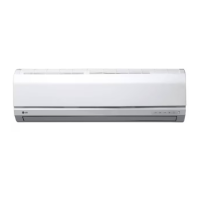
Do you have a question about the LG SJ122CD and is the answer not in the manual?
| Type | Split System |
|---|---|
| Cooling Capacity | 12000 BTU/h |
| Refrigerant | R410A |
| Power Supply | 220-240V, 50Hz |
| Power Consumption (Cooling) | 1120 W |
| Operating Temperature (Cooling) | 18°C to 43°C |
Critical safety measures for installing the air conditioner to prevent electrical hazards and damage.
Key safety instructions for operating the air conditioner to prevent accidents and ensure proper function.
Further installation safety points, including drain hose, gas leak inspection, and level installation.
Operational advice for ventilation, cleaning, and avoiding obstacles for optimal performance.
Explains the meaning of symbols used in the manual for hazard and note indication.
Lists the necessary parts required for the installation process.
Lists the essential tools required for performing the installation.
Guidelines for selecting the optimal indoor unit location, considering clearance and wall mounting.
Guidelines for selecting the optimal outdoor unit location, considering space, heat, and noise.
Steps for preparing and connecting the indoor unit's piping and drain hose through the wall.
Procedure for routing and connecting piping and cables for right rear installation.
Steps for wrapping insulation material and bundling pipes and hoses for protection.
Steps to ensure the indoor unit is properly seated on the installation plate.
Steps to ensure the indoor unit is properly seated on the installation plate.
Connecting wires to the indoor unit's control board according to color codes and terminal numbers.
Specifications for selecting appropriate power cords (Type 'B') based on unit capacity and standards.
Important cautions regarding wiring, circuit breakers, power source, and voltage for safe operation.
Procedure for removing air and moisture from the refrigerant system using a vacuum pump.
Instructions for inserting batteries into the remote controller for operation.
Guidelines for securely anchoring the outdoor unit to prevent movement from vibration or external forces.
Checking system refrigerant charge and air temperature difference to confirm performance.
Procedure for collecting refrigerant into the outdoor unit for servicing or relocation without loss.
